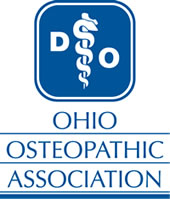Happy Quasquicentennial!
Marking a Milestone
(December 31, 2023) What do you do on New Year’s Eve? Do you spend time with family, friends, colleagues? Most likely you ring in the new year with a toast.
Exactly 125 years ago, on New Year’s Eve 1898, a group of DOs celebrated the new year and toasted to their new professional group: the Ohio Society for the Advancement of Osteopathy.
They met in Columbus at the home of MF Hullet, DO, and elected a Cincinnati physician, George W. Sommer, DO, as the first president of the group—which would later be called the Ohio Osteopathic Society and then the Ohio Osteopathic Association.
Ohio was definitely at the forefront of osteopathic medicine. It was just six short years before that memorable NYE that the American School of Osteopathy was founded. In fact, the May 1902 edition of the Journal of Osteopathy listed Ohio among the 15 states where osteopathy is legalized and regulated by the state legislature.
But it wasn’t smooth sailing in those first years. A number of DOs were arrested for not having a license to practice. The Ohio Supreme Court ruled that the Ohio Medical Practice Act (1896) did not apply to osteopathy, leaving DOs in a practice limbo. The Love Act (1900) passed the Ohio General Assembly and established a four-year educational curriculum for DOs which was actually a higher standard than what existed for MDs at that time—effectively prohibiting osteopathy from being practiced legally. Therefore, DOs refused to register under the new law and the association pledged to financially assist them with legal fees.
In the early 1900s, things started to shift for DOs in Ohio. Through strong leadership and the active lobbying efforts of the association, the medical laws were amended to recognize osteopathic medicine. With this formal recognition, the profession began a period of unprecedented growth that cemented its gains, impressed upon patients the value of osteopathic treatment, and gained equal practice rights.
There were three major events in 1901:
First, the OOA was incorporated. The effort was led by Clarence Kerr, DO; MF Hulett, DO; George J. Eckert, DO; William A. Gravett, DO; JTL Morris, DO; ER Booth, DO; and HG Dilleon, DO.
Second, the Ohio Supreme Court ruled the Love Bill unconstitutional:
Medical law includes osteopathy but the Love Bill is void as to osteopaths because while giving them a limited certificate which does not entitle them to prescribe drugs or perform surgery, it requires four years of preparatory study which it does not require of regular practitioners whose certificates to practice authorizes them to engage in the unlimited practice of medicine and surgery.
Lastly, ER Booth, DO, of Cincinnati was the first Ohioan to be elected president of the American Osteopathic Association (AOA).
Other significant events included the first DO licensing exam given by the State Medical Board of Ohio, the 1903 AOA national convention in Cleveland, and the first graduating class from the Ohio College of Osteopathy in Chillicothe in 1904.
By the time of America’s entry into World War I, Ohio was well represented in the profession, providing two AOA presidents; hosting several national conventions; building numerous hospitals and health clinics; and establishing women’s auxiliary societies to help finance scholarships, student loans, and research. The profession lost ground during the Depression, but regained it slowly until July 31, 1943, when full practice rights were achieved. That same year, JO Watson, DO, of Columbus, became the first DO to serve on the State Medical Board—a position he retained for nearly 30 years. Yet, not until Public Law 763 was signed by President Dwight D. Eisenhower in 1956 were DOs commissioned in the medical corps of the armed services.
In the early 70s, OOA leadership had the foresight and determination to establish an osteopathic medical school in the state. The OOA House of Delegates unanimously approved a resolution to assess themselves and all members an extra $250 annually for six years to support the new College of Osteopathic Medicine.
For many, passage of HB 229 in 1975 is considered the OOA’s greatest accomplishment. Creating the osteopathic medical school at a public university was a tough battle, particularly with powerful opposition from the Ohio Board of Regents and Ohio State Medical Association. But on June 7, 1980, Ohio University graduated its first 21 physicians who received the DO degree. Today, over 1,000 students are enrolled at Ohio University Heritage College of Osteopathic Medicine’s three campuses in Athens, Dublin, and Cleveland. The College alumni totals 4,500+, with physicians in every specialty and 60% practicing in Ohio.
In 1898 there were 15 osteopathic physicians practicing in the Buckeye State. Today, our state counts 8,228 DOs.
As we celebrate this quasquicentennial let’s reflect on the OOA’s distinguished past which has paved the road to our dynamic future. Here’s to the next 125 years!
Excerpts from A Second Voice: A Century of Osteopathic Medicine in Ohio, CP Miller; Bulletin of the History of Medicine, JS Haller



